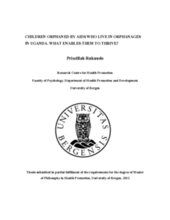Abstract
The study aimed at finding out what enables children orphaned by AIDS who live in orphanages to thrive. In Africa, many orphaned children are looked after by relatives in their extended families. Currently, these traditional safety nets have been weakened by the increasing number of orphaned children mainly caused by AIDS and related diseases. Other factors like poverty and unemployment have also contributed to relatives’ inability to continuously care for extra children. This has resulted into alternative living arrangements like orphanages and child headed household. Orphanages are still not a preferred alternative form of care in most African countries but they exist. Many researchers and the International body are against institutionalization of children citing out that it causes harm to children. Nevertheless, some children who live in orphanages may be thriving. This raises the question of what enables them to thrive despite the negative aspects associated with this form of care.
The study’s main objective was; what enables children orphaned by AIDS who live in orphanages to thrive. The specific questions were; a) what can orphanages offer that relatives and communities cannot offer, b) how do orphaned children cope with different challenges, c) how do orphaned children perceive their psychological well-being, d) how do the preventive behaviors and educational programs that children are provided with influence them, e) what is the orphaned children’s social life like in and out of the orphanage.
Qualitative research design was used and participants were purposively selected. Data were collected from 20 participants; 12 children and 3 ‘mothers’ from Ssubi Village, 2 caregivers from SOS Children’s Village, 2 social workers from Ashinaga-Uganda and 1 old boy who once lived in an orphanage. Data were collected through in-depth interviews and observations. They were analyzed using the ‘thematic networks’ method of analysis that is explained by Attride-Stirling.
The study applied the theory Salutogenesis that was coined by Aaron Antonovsky whose aim is to understand what factors facilitate health and well-being in the face of adversity. The theory of Resilience and the theory of Attachment have also been used to explain how one can achieve good health despite challenges faced.
Findings of the study confirmed that children’s basic needs are adequately provided and children are taught about AIDS prevention. There is huge gap that is created between children who live in orphanages and their relatives and there were suggestions that there is need for community-based care. Children experienced challenges like stigma, marginalization, grief and missing their relatives but there were different coping strategies in place. For instance, counseling, praying, ignoring and avoiding. One problem seemed to have no specific solution; adapting to life after orphanage care.
Findings of the study revealed that different factors work hand in hand in enabling children to thrive. They include; the love and care from ‘mothers’, different resources/GRRs for coping with challenges and other personal attributes like intelligence and self-esteem. There is no single factor in isolation that can be said to facilitate thriving in this group of children.

